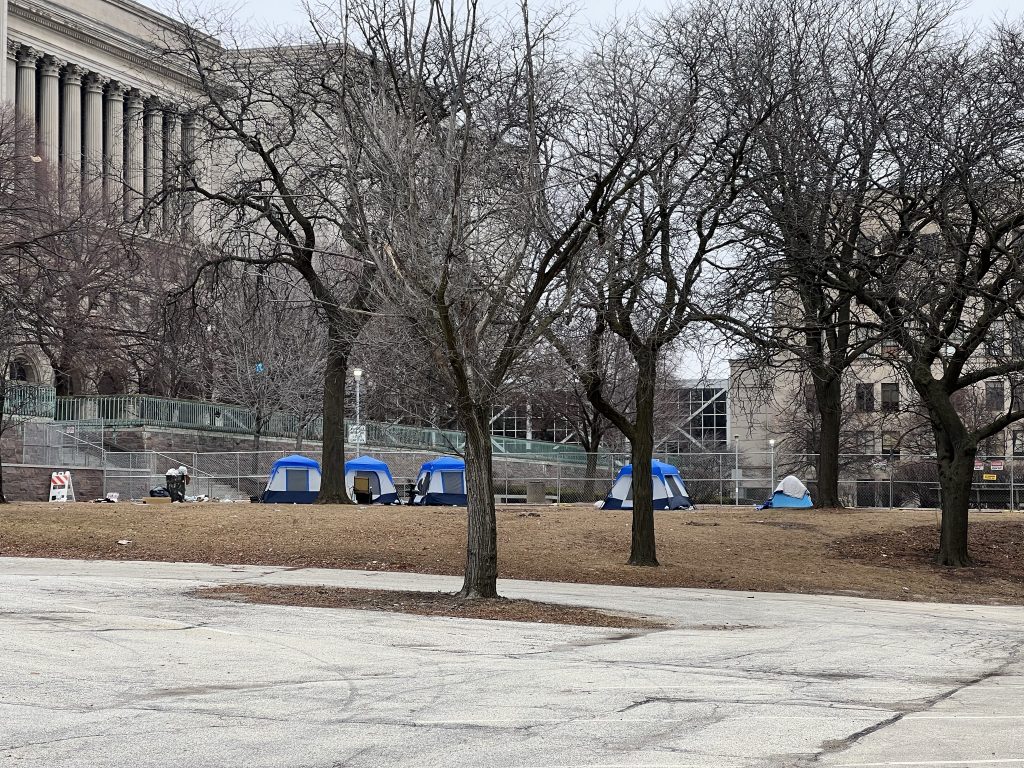Homelessness Increasing in Milwaukee
Began rising during pandemic and has continued since then, new report finds.

A homeless tent encampment on the edge of MacArthur Square. Photo by Jeramey Jannene.
Homelessness is on the rise in Milwaukee and Wisconsin.
The latest data suggests that homelessness has increased in recent years after a decade of progress on this issue. The likely culprit, it seems, is the economic tumult caused by the COVID-19 pandemic, according to the Wisconsin Policy Forum, a nonpartisan research organization. Its recent report also suggests the decline in homelessness during the past decade resulted from national and local policy changes prioritizing stable, permanent housing over transitional beds and shelters.
“The rise in homelessness likely was driven – at least initially – by the layoffs and economic hardships that accompanied the pandemic and, more recently, by rising housing costs that arrived in the wake of COVID-19,” the forum states, in a report that looks at local and state numbers.
Milwaukee County still has fewer reported homeless than a decade ago, but the number increased in 2022 and data from the Department of Housing and Urban Development confirms that trend continued in 2023. Housing professionals and advocates suspected the increase would continue in 2023.
Using “point-in-time” counts of the number of people facing homelessness — a metric the forum notes is imperfect — the report shows that between 2014 and 2021 local housing agencies were recording fewer and fewer numbers of people experiencing street homelessness or in emergency shelter; falling from 6,055 in 2014 to 4,237 in 2021. This data doesn’t capture the people living with friends, family or in permanent housing programs, but it is a statistic reported annually to HUD.
The change in reported homelessness during the last decade was largely driven by the adoption of housing-first policies. First, HUD reoriented its grantmaking practices to prioritize longterm or permanent housing programs over temporary shelter-based programs. Housing agencies naturally reacted to this change in the flow of federal funding. Second, Milwaukee County formally adopted its own Housing First policy, which has led to a decline in unsheltered homelessness for both Milwaukee and the state, with the downward numbers largely driven by declines in Milwaukee.
A housing-first policy means providing stable shelter before addressing the underlying reasons causing a person to become homeless. “This differs from temporary housing, which is designed to be an intermediate step that allows individuals to address their challenges in advance of seeking permanent placement,” the policy forum notes.
Permanent housing means a few different things to HUD. Generally, it refers to housing without designating how long someone lives there. It also includes rapid rehousing programs that quickly place someone in permanent shelter, but which also limit the time someone stays there; typically 24 months.
The number of people reported in transitional housing programs — which provide shelter and supportive services until permanent housing is secured — has been declining. This change, the forum believes, has occurred as more people end up in permanent housing programs. With federal funding redirected to permanent housing programs, in line with the housing first philosophy, more have been created.
Since 2014, there has been an increase of 4,720 permanent housing beds in the state. While transitional beds have dwindled, the total number of beds for homelessness programs in the state has increased by 27%, increasing to 12,197, the forum reports.
“The steady increase in permanent beds indicates that while the number of unsheltered and temporarily sheltered individuals have decreased on the point-in-time reports, the demand for housing services has not,” the forum notes.
The report attributes the recent rise in unsheltered homelessness to pandemic layoffs, inflation and rising housing costs. Federal stimulus funding was used to great effect on housing and homelessness programs by the state and local governments, but that funding is running out, or already has.
Read the full report on Urban Milwaukee.
If you think stories like this are important, become a member of Urban Milwaukee and help support real, independent journalism. Plus you get some cool added benefits.
MKE County
-
Ron Johnson Says Free-Market Principles Could Fix Education
 Jul 17th, 2024 by Graham Kilmer
Jul 17th, 2024 by Graham Kilmer
-
RNC Will Cause Some County Services To Be Moved to Wauwatosa
 Jul 12th, 2024 by Graham Kilmer
Jul 12th, 2024 by Graham Kilmer
-
Hank Aaron State Trail Will Be Closed For RNC, State Fair
 Jul 12th, 2024 by Graham Kilmer
Jul 12th, 2024 by Graham Kilmer





















